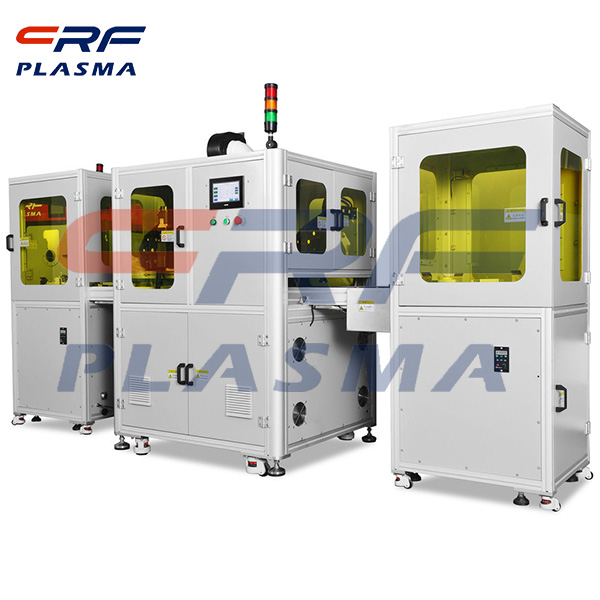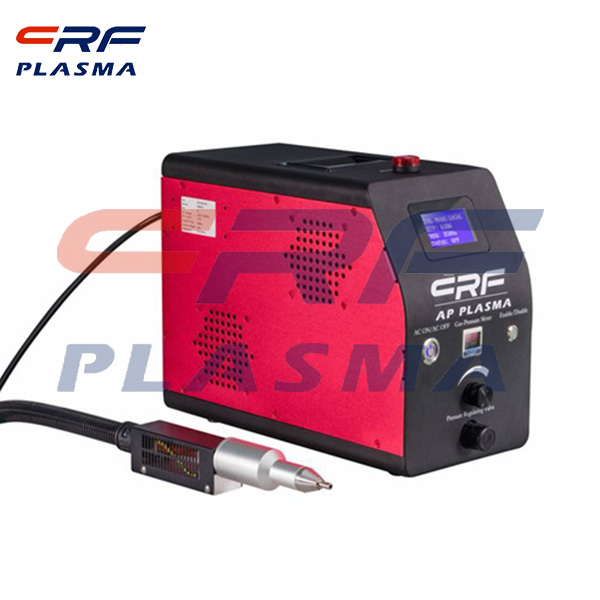
Welcome to Shenzhen Sing Fung Intelligent Manufacturing Co., Ltd.
E-mail:shaobo@sfi-crf.com
Plasma surface activator
- Categories:Industry News
- Author:plasma cleaning machine-surface treatment equipment-CRF plasma machine-Sing Fung Intelligent Manufacturing
- Origin:
- Time of issue:2020-10-22
- Views:
(Summary description)The surface of the material must have good wettability, so that it can be well bonded with the adhesive material in painting, bonding, printing or pressure welding. Not only does dirt containing oil and grease prevent wetting, but the surfaces of many materials cannot be completely wetted by various fluids, adhesives, and coatings. After the liquid drops, even after curing and drying, it cannot be well attached to the surface. The surface can be activated and treated with the plasma surface activator. This is because the substrate has a low surface energy. Normally, materials with a low surface energy are those with a high surface energy that can be wetted, but conversely, materials with a high surface energy are those that cannot be wetted. The surface energy of the liquid added, also known as surface tension, must in any case be lower than the surface energy of the substrate. Most plastics have a very low surface energy, and because the surface is nonpolar, liquid molecules cannot find connections where they can aggregate and therefore cannot be wetted by adhesives and coatings. The surface energy of the material surface is increased so that the surface is activated and the activated surface establishes a gathering point for the added liquid. Chemical primers and liquid adhesion promoters can generally be used to activate the material surface. But the treatment is often corrosive and harmful to the environment. On the one hand, adequate ventilation must be carried out before follow-up processing; on the other hand, activation state cannot be maintained for a long time. Nonpolar materials such as polyolefin cannot be fully activated by chemical primers. In addition, it can be activated in the arc corona. This is a form of atmospheric pressure plasma surface activated machine treatment, but only for flat or convex surfaces, where an arc is introduced. For atmospheric plasma activation cleaning machine, arc plasma will be ejected through the nozzle, so the surface of complex parts can also be activated. When activated in an air or oxygen plasma, the nonpolar hydrogen bonds of plastic polymers can be replaced by oxygen bonds. It can provide free valence electrons to bond with liquid molecules, thus improving the surface polarity. "Non-viscous" plastics, such as polyformaldehyde, polyethylene and polypropylene, can also have good adhesion and sprayability when activated by plasma at low or atmospheric pressure. The required surface energy can be adjusted very precisely, which also prevents over-activation, which can lead to etching. In a low pressure plasma, gases other than air and oxygen can be used, and these gases must be able to adsorb nitrogen (N2), amine (NHx), or carbonyl (-COOh) at the position of oxygen as the reaction group. The surface of the plastic remains active for 24 hours. However, follow-up treatment should be carried out as soon as possible, because with aging, new dirt will be absorbed. Adhesion of PTFE can also be achieved by plasma treatment, however it is not activated but etched. Metals, ceramics and glass usually have higher surface energy than plastics. If they need to be bonded or printed, it is advantageous to use plasma-surface activators for activation. The surface tension of the solder alloy is very high, however, some of it will still come off the metal surface. Therefore, plasma activation can improve the wettability during the welding process. The activation of the metal is mostly short and the welding must be carried out immediately.
Plasma surface activator
(Summary description)The surface of the material must have good wettability, so that it can be well bonded with the adhesive material in painting, bonding, printing or pressure welding. Not only does dirt containing oil and grease prevent wetting, but the surfaces of many materials cannot be completely wetted by various fluids, adhesives, and coatings. After the liquid drops, even after curing and drying, it cannot be well attached to the surface. The surface can be activated and treated with the plasma surface activator.
This is because the substrate has a low surface energy. Normally, materials with a low surface energy are those with a high surface energy that can be wetted, but conversely, materials with a high surface energy are those that cannot be wetted. The surface energy of the liquid added, also known as surface tension, must in any case be lower than the surface energy of the substrate. Most plastics have a very low surface energy, and because the surface is nonpolar, liquid molecules cannot find connections where they can aggregate and therefore cannot be wetted by adhesives and coatings. The surface energy of the material surface is increased so that the surface is activated and the activated surface establishes a gathering point for the added liquid.
Chemical primers and liquid adhesion promoters can generally be used to activate the material surface. But the treatment is often corrosive and harmful to the environment. On the one hand, adequate ventilation must be carried out before follow-up processing; on the other hand, activation state cannot be maintained for a long time. Nonpolar materials such as polyolefin cannot be fully activated by chemical primers.
In addition, it can be activated in the arc corona. This is a form of atmospheric pressure plasma surface activated machine treatment, but only for flat or convex surfaces, where an arc is introduced. For atmospheric plasma activation cleaning machine, arc plasma will be ejected through the nozzle, so the surface of complex parts can also be activated.
When activated in an air or oxygen plasma, the nonpolar hydrogen bonds of plastic polymers can be replaced by oxygen bonds. It can provide free valence electrons to bond with liquid molecules, thus improving the surface polarity. "Non-viscous" plastics, such as polyformaldehyde, polyethylene and polypropylene, can also have good adhesion and sprayability when activated by plasma at low or atmospheric pressure. The required surface energy can be adjusted very precisely, which also prevents over-activation, which can lead to etching.
In a low pressure plasma, gases other than air and oxygen can be used, and these gases must be able to adsorb nitrogen (N2), amine (NHx), or carbonyl (-COOh) at the position of oxygen as the reaction group.
The surface of the plastic remains active for 24 hours. However, follow-up treatment should be carried out as soon as possible, because with aging, new dirt will be absorbed. Adhesion of PTFE can also be achieved by plasma treatment, however it is not activated but etched.
Metals, ceramics and glass usually have higher surface energy than plastics. If they need to be bonded or printed, it is advantageous to use plasma-surface activators for activation. The surface tension of the solder alloy is very high, however, some of it will still come off the metal surface. Therefore, plasma activation can improve the wettability during the welding process. The activation of the metal is mostly short and the welding must be carried out immediately.
- Categories:Industry News
- Author:plasma cleaning machine-surface treatment equipment-CRF plasma machine-Sing Fung Intelligent Manufacturing
- Origin:
- Time of issue:2020-10-22 08:35
- Views:
The surface of the material must have good wettability, so that it can be well bonded with the adhesive material in painting, bonding, printing or pressure welding. Not only does dirt containing oil and grease prevent wetting, but the surfaces of many materials cannot be completely wetted by various fluids, adhesives, and coatings. After the liquid drops, even after curing and drying, it cannot be well attached to the surface. The surface can be activated and treated with the plasma surface activator.
This is because the substrate has a low surface energy. Normally, materials with a low surface energy are those with a high surface energy that can be wetted, but conversely, materials with a high surface energy are those that cannot be wetted. The surface energy of the liquid added, also known as surface tension, must in any case be lower than the surface energy of the substrate. Most plastics have a very low surface energy, and because the surface is nonpolar, liquid molecules cannot find connections where they can aggregate and therefore cannot be wetted by adhesives and coatings. The surface energy of the material surface is increased so that the surface is activated and the activated surface establishes a gathering point for the added liquid.
Chemical primers and liquid adhesion promoters can generally be used to activate the material surface. But the treatment is often corrosive and harmful to the environment. On the one hand, adequate ventilation must be carried out before follow-up processing; on the other hand, activation state cannot be maintained for a long time. Nonpolar materials such as polyolefin cannot be fully activated by chemical primers.
In addition, it can be activated in the arc corona. This is a form of atmospheric pressure plasma surface activated machine treatment, but only for flat or convex surfaces, where an arc is introduced. For atmospheric plasma activation cleaning machine, arc plasma will be ejected through the nozzle, so the surface of complex parts can also be activated.
When activated in an air or oxygen plasma, the nonpolar hydrogen bonds of plastic polymers can be replaced by oxygen bonds. It can provide free valence electrons to bond with liquid molecules, thus improving the surface polarity. "Non-viscous" plastics, such as polyformaldehyde, polyethylene and polypropylene, can also have good adhesion and sprayability when activated by plasma at low or atmospheric pressure. The required surface energy can be adjusted very precisely, which also prevents over-activation, which can lead to etching.
In a low pressure plasma, gases other than air and oxygen can be used, and these gases must be able to adsorb nitrogen (N2), amine (NHx), or carbonyl (-COOh) at the position of oxygen as the reaction group.
The surface of the plastic remains active for 24 hours. However, follow-up treatment should be carried out as soon as possible, because with aging, new dirt will be absorbed. Adhesion of PTFE can also be achieved by plasma treatment, however it is not activated but etched.
Metals, ceramics and glass usually have higher surface energy than plastics. If they need to be bonded or printed, it is advantageous to use plasma-surface activators for activation. The surface tension of the solder alloy is very high, however, some of it will still come off the metal surface. Therefore, plasma activation can improve the wettability during the welding process. The activation of the metal is mostly short and the welding must be carried out immediately.

Scan the QR code to read on your phone

TEL:0755-3367 3020 / 0755-3367 3019

E-mail:sales-sfi@sfi-crf.com

ADD:Mabao Industrial Zone, Huangpu, Baoan District, Shenzhen

















